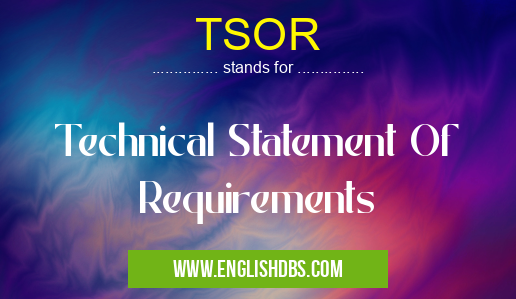What does TSOR mean in PLANNING
TSOR stands for Technical Statement of Requirements. It is a document released by governmental bodies that outlines the requirements and criteria for a product or service they wish to purchase. This document outlines technical specifications, standards, and guidelines that must be met before the government can make their purchase. In addition to requirements related to the product or service, TSORs also address potential suppliers' capabilities, pricing models, delivery terms, warranties, and other associated details. TSORs provide guidance on the performance of specific activities in order to meet the government's needs. They are used as a way to communicate clearly what is required by the purchasing entity so that suppliers can respond with proposals that meet those requirements.

TSOR meaning in Planning in Governmental
TSOR mostly used in an acronym Planning in Category Governmental that means Technical Statement Of Requirements
Shorthand: TSOR,
Full Form: Technical Statement Of Requirements
For more information of "Technical Statement Of Requirements", see the section below.
» Governmental » Planning
Definition
A Technical Statement of Requirements (TSOR) is a document released by an agency of government that outlines its requirements for a product or service it wishes to purchase. The TSOR outlines technical specifications and standards in order to ensure that potential suppliers have adequate capabilities and offerings to meet the specific needs of the government agency. It also addresses pricing models, delivery terms, warranties, and other associated details so that supplier responses are able to meet all of the necessary criteria outlined in this document.
Essential Questions and Answers on Technical Statement Of Requirements in "GOVERNMENTAL»PLANNING"
What is a TSOR?
A Technical Statement of Requirements (TSOR) is a document created to provide an overview of the tasks and objectives associated with a particular project. This document outlines the expected outcomes, details timelines and resources needed, establishes any applicable regulatory or legal requirements, and provides cost estimates.
Why do I need a TSOR?
A Technical Statement of Requirements allows all stakeholders to work together on a common understanding of the project goals. It ensures that everyone involved has access to the same information for decision-making purposes and helps to prevent misunderstandings about scope, timeline, budget, or other critical components.
Who contributes to a TSOR?
The team that creates a Technical Statement of Requirements depends on the nature of the project. Generally speaking, it includes key stakeholders (such as management), technical experts, regulatory specialists, engineers or other professionals who are necessary for success in completing the task at hand.
What are some examples of TSOR contents?
The content of a Technical Statement of Requirements will depend on the specifics of each individual project. Generally speaking, it should provide sufficient detail about scope, timeline, budget, staff requirements (and/or subcontractors), deliverables or end products, safety guidelines or regulatory standards associated with the task at hand.
How does a TSOR help ensure successful completion of projects?
A well-defined Technical Statement of Requirements provides everyone involved with clear expectations and objectives from start to finish. It serves as an essential reference throughout the course of the project by providing consistent guidelines that all parties can use for progress tracking and quality assurance purposes.
Is there any flexibility in revising TORS once they are in place?
Yes – depending upon circumstances that may arise during development and implementation stages; revisions can be made to reflect changes in direction or scope as needed for successful completion. However – any changes should be evaluated by all stakeholders in order to ensure that everyone is still working toward achieving goals stated in the original TORS document.
How often should teams review their TORS documents?
Team members should review their TORS documents regularly throughout development stages so that any potential adjustments can be made based on progress reports and changing needs. Regular reviews allow teams to track progress more closely and make sure they are still focused on meeting goals set forth in their TORS document.
Is there only one type of TORS format available?
No - While there are some universal components included in most TORS documents; each team is free to create unique formats that meet their specific needs based upon industry standards or requirements established by governing bodies overseeing individual projects.
What happens after completion of a project outlined by TORS?
After successful completion of tasks outlined by a Technical Statement Of Requirement (TORS); individual stakeholders must conduct post-project evaluations in order to assess performance against goals defined within TORS documents before closing out overall projects for sign offs from all parties involved.
Final Words:
Overall, Technical Statements of Requirements are documents created by governmental bodies in order to accurately communicate their needs for products or services they wish to acquire. These documents outline detailed technical specifications and standards as well as terms related to pricing models, delivery terms, warranties and more so that suppliers can respond appropriately with proposals meeting all required criteria set forth in this document. By providing such clear communication about what is needed up front from these entities’ prospective buyers; it enables them to make faster decisions about who they will choose for their supplier in essence streamlining the procurements completion process significantly.
